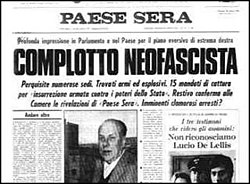Golpe Borghese
| Golpe Borghese | |||
|---|---|---|---|
| Part of Neo-fascism in Italy | |||

Front page of the newspaper Paese Sera on the failed neo-fascist coup
|
|||
| Date | 7–8 December 1970 | ||
| Location | Rome, Italy | ||
| Goals | Overthrow of centre-left national government | ||
| Methods | Coup d'etat | ||
| Result | Coup was suspended | ||
| Parties to the civil conflict | |||
|
|||
| Lead figures | |||
|
|
|||
The Golpe Borghese was a failed Italian coup d'état allegedly planned for the night of 7 or 8 December 1970. It was named after Junio Valerio Borghese, an Italian World War II commander of the Xª MAS unit, the "Black Prince", convicted of fighting with Nazi Germany but not of war crimes, but still a hero in the eyes of many post-War Italian fascists. The coup attempt became publicly known when the left-wing journal Paese Sera ran the headline on the evening of March 18, 1971: Subversive plan against the Republic: far-right plot discovered.
The secret operation was code-named 'Operation Tora Tora' after the Japanese attack on the US ships in Pearl Harbor which had led the United States to enter the Second World War on December 7, 1941. The plan of the coup in its final phase envisaged the involvement of US and NATO warships which were on alert in the Mediterranean. However, only a few marginalized sectors of the US Central Intelligence Agency (CIA) were in favour of the coup, while the main response was not to allow major changes in the geo-political balance in the Mediterranean.
The botched right-wing coup took place after Hot Autumn of left-wing protests in Italy and the Piazza Fontana bombing in December 1969. The failed attempt involved hundreds of neo-fascist militants from Stefano Delle Chiaie's National Vanguard, helped by 200 members of the Corpo Forestale dello Stato. The plan included the kidnapping of the Italian President Giuseppe Saragat, the murder of the head of the police Angelo Vicari, and the occupation of the Quirinale, the Ministry of the Interior, the Ministry of Defense and Italian public television broadcaster RAI. Certain Army dissidents also planned to occupy Sesto San Giovanni, at that time a workers' town and a stronghold of the Italian Communist Party. Apparently some militants briefly entered the Ministry of the Interior, but Borghese suspended the coup a few hours before its final phase.
...
Wikipedia
